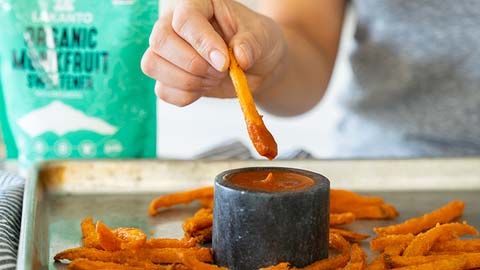A Complete Guide to Lakanto's Monk Fruit Sweeteners
So you wanna know about Lakanto Monkfruit Sweeteners, eh? Buckle up as we take a tour of each one and explain what they were designed to do, how they are different, and what recipes each are generally used in. By the end of this ride you’ll be a sweetener expert and won’t even flinch when friends ask which sweetener works best in buttercream frosting (...psst, the answer is Powdered Sweetener).
Classic Monkfruit Sweetener

Lakanto Classic Monkfruit Sweetener can be used as a substitute for granulated white sugar. Lakanto’s proprietary formula of monk fruit extract and erythritol make it the perfect blend of sweetness and texture for substituting into all your favorite baked goods. Fun fact: unlike processed sugars, Classic is naturally white and remains unbleached.
Maybe you’re wondering, “what’s the difference between Classic and Powdered Sweetener?” Glad you asked! For starters they have the same flavor. Though, since Powdered is, well, a powder, it can easily dissolve in frostings and can be a finishing sprinkle on top of pastries that granulated sweeteners wouldn’t typically be used for. Learn more about Classic in our article How to Bake with Lakanto Classic Monkfruit Sweetener.
What Classic Monkfruit Sweetener is commonly used in: brownies, cookies, cakes, cheesecakes, pies, seasoning, sauces, simple syrups, smoothies, mixed into oatmeal, or even sprinkled on top of cereal.
Organic Monkfruit Sweetener

If you’re looking to go organic, look no further than our certified-organic substitute. We make sure to conduct extensive third-party testing on all our ingredients. In this case, the organic certification gives you the peace of mind of knowing that this specific sweetener went through even more tests than the traditional sweetener. So, if you’re looking for high-quality, tried and tested ingredients, this one's got your name written all over it.
Does Organic Monkfruit Sweetener taste different than Classic Monkfruit Sweetener? Nope, they have the same taste and granulated texture. Even though all Lakanto products use non-GMO or organic ingredients, Organic Monkfruit Sweetener goes through the extra steps to be officially certified organic. We call it peace of mind. Learn more about Organic Monkfruit Sweetener here.
What Organic Monkfruit Sweetener is commonly used in: (exactly the same as Classic Monkfruit Sweetener!) brownies, cookies, cakes, cheesecakes, pies, seasoning, sauces, simple syrups, smoothies, mixed into oatmeal, or even sprinkled on top of cereal.
Powdered Monkfruit Sweetener

Lakanto Powdered Monkfruit Sweetener is a great substitute for recipes that traditionally call for powdered sugar (also called confectioners sugar or icing sugar). The smooth blend of monk fruit extract and erythritol dissolves easily into frosting or whipped cream, and can be dusted on desserts as a sweet decoration. The final result is an alternative powdered sweetener that tastes like powdered sugar. Learn more about Powdered in our article How To Bake With Lakanto Monkfruit Sweetener.
Best uses for Lakanto Powdered Sweetener: frosting, royal icing, glaze, dusting or sprinkling on top of baked goods, gelatin, mousse, whipped cream, pie, shortbread cookies, sorbet, and ice cream.
Monkfruit Baking Sweetener

It’s all about texture with baking sweetener. Not only does it dissolve easily but it helps baked goods like cookies spread and brown. People use it not only for baking, but for other desserts when they want a more powdered texture, such as cheesecake, and sauces. In the baking world it can be one of the most versatile ingredients. Looks like powdered sugar, tastes like regular white sugar.
What’s the difference between Classic Monkfruit Sweetener and Monkfruit Baking Sweetener? Baking Sweetener helps your sugar-free baked goods go the extra mile by achieving some of the same baking properties as sugar such as: browning, spreading, and dissolving easily. Learn more about Baking Sweetener in our article How To Use Lakanto Monkfruit Baking Sweetener.
Lakanto Monkfruit Baking Sweetener works great in recipes such as: donuts, brownies, cookies, cake, cheesecake, pie, pastry dough, muffins, gelatin, mousse, whipped cream, ice cream, and sorbet.
Brown Monkfruit Sweetener

With a consistency that’s both soft and moist, Lakanto Brown Sweetener is soon to be a favorite! It’s a true brown sugar replacement that leaves sugary molasses in the past and makes friends with natural flavor (which gives it that sweet scent and flavor of traditional brown sugar).
So, how are Brown Sweetener and Golden different? Golden has a mapley taste and is a dry granular texture used to replace raw cane sugar. Brown Sweetener has a caramel-like taste similar to brown sugar and is moist so it can pack into measuring cups. Want to find out more? Check out 10 Things You Didn’t Know about Lakanto Brown Monkfruit Sweetener.
Lakanto Brown Monkfruit Sweetener works great in: cookies, pies, cinnamon rolls, sauces, marinades, meat glazes, and recipes that normally call for a brown sugar replacement.
Golden Monkfruit Sweetener

Looks and tastes like raw cane sugar (also called turbinado or Demerara sugar). It’s similar to Classic in sweetness, but offers a more complex mapley flavor, just as raw cane sugar does. Its golden color is natural, coming from different parts of the monk fruit which also gives it the warm mapley taste. When it comes to texture, Golden has a finer granular crystal than regular raw cane sugar, which means it dissolves just as easily as Classic and creates the texture you’re looking for in your recipes! When substituting Golden to replace sugar, start with a general ratio of 1:1, substituting 1 cup of raw cane sugar with 1 cup of Lakanto Golden Monkfruit Sweetener. Learn more about Golden in our article How To Bake With Lakanto Golden Monkfruit Sweetener.
What Lakanto Golden Monkfruit Sweetener is often used for: cookies, brownies, cakes, pies, muffins, cinnamon rolls, scones, biscuits, sauces, salad dressings, seasonings, dry rubs, meat glaze, marinades, simple syrups, smoothies, or sweetening coffee and tea.

Now that you know the difference between our Monkfruit Sweeteners, head to the sweeteners page to stock up! Looking for more baking resources? Soak up all the knowledge and download our printable Baking Guide. Expert chefs Vanessa Musi, Blaire Flory, and Angelina Papanikolaou share their experience with each sweetener in the guide so you can check-off all your baking goals this year!



